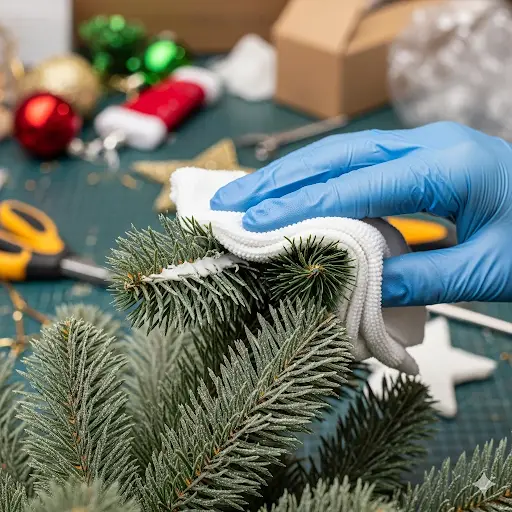Alright, friend, let’s talk about that moment of truth every year: pulling out the holiday decorations. You get to the artificial Christmas tree box, filled with hope and festive cheer, and then… a cloud of dust and that slightly musty smell of a year in storage. Ugh. It’s a sad sight, and honestly, a little gross. But what if I told you that getting your tree sparkling clean doesn’t have to be a monumental task? I’m here to show you exactly how to clean an artificial christmas tree so it looks brand new, smells fresh, and is ready to be the centerpiece of your holiday season. Forget the dust bunnies—we’re going for holiday magic!
Why You Absolutely Need to Clean Your Christmas Tree (It’s Not Just for Looks!)
You might be tempted to just fluff out the branches and start decorating. But trust me, giving your tree a proper clean is one of the best things you can do.
- Banish Allergens: That dust, dirt, and pet dander that have accumulated all year? They’re an allergy nightmare waiting to happen. A good cleaning removes all those potential triggers, making your holiday a lot more comfortable.
- Restore Its Brilliance: A dusty tree looks dull and lifeless. A clean tree? It’s vibrant, the colors are bright, and it truly sparkles under the holiday lights.
- Extend Its Lifespan: Proper cleaning and care prevent dirt and grime from causing long-term damage, ensuring your tree lasts for many years to come.
- Eliminate Musty Smells: That “year in storage” smell is no fun. A good cleaning gets rid of that musty odor and leaves your home smelling fresh and ready for the holidays.
This isn’t just about making your tree look good; it’s about making your home feel good, too.
The Cleaning Arsenal: Your Tools for a Sparkling Tree
Good news! You don’t need a lot of harsh chemicals for this task. Your secret weapons are a mix of simple household items and a little bit of elbow grease.
What You’ll Need:
- A Soft-Bristle Brush or Microfiber Duster: This is your first line of defense for a dry clean.
- A Vacuum with a Brush Attachment: Your most powerful weapon for removing stubborn dust.
- A Handheld Vacuum or Hair Dryer (on cool setting): For reaching hard-to-get spots and blowing dust out of crevices.
- Mild Dish Soap or Distilled White Vinegar: For a deeper clean and tackling musty smells.
- Warm Water & A Spray Bottle: Your base for a gentle cleaning solution.
- Microfiber Cloths or Rags: For wiping down the branches.
- A Large Drop Cloth or Sheet: To catch all the debris and make cleanup a breeze.
- Gloves and a Face Mask (Optional but Smart!): To protect yourself from inhaling dust.
How to Clean an Artificial Christmas Tree: A Step-by-Step Guide
Alright, let’s get down to business. I’m going to walk you through the process, from dusting to deep cleaning, so your tree is ready for its holiday debut. This is the simplest and most effective guide for cleaning an artificial christmas tree.
Step 1: The Dry Clean – Brushing and Dusting
Before you introduce any liquid, you need to get rid of all that loose dust and debris. This prevents you from just turning the dust into a muddy mess.
- Prepare Your Space: Lay down a large sheet or drop cloth.
- Unplug and Un-deck: Unplug the tree if it’s pre-lit. Remove all ornaments, lights, and decorations.
- Brush from Top to Bottom: Use your soft-bristle brush or microfiber duster and start from the top of the tree, working your way down. Gently brush each branch, getting into the nooks and crannies.
- Vacuum with Care: For a deeper clean, use your vacuum cleaner’s brush attachment (on a low setting!) to suck up dust from the branches. Be gentle to avoid bending the needles. For pre-lit trees, hold the vacuum slightly away from the bulbs to avoid damage.
- Blast the Crevices: Use a hair dryer on a cool setting or a can of compressed air to blow stubborn dust out of the spots where branches meet the trunk. This is an awesome hack for a truly deep clean.
Step 2: The Wet Clean – For Sticky Spots and Grime
This step is for when your dry clean isn’t enough. It’s how you tackle grime, sticky residue, and that stubborn musty odor from storage.
- Mix Your Solution: In a spray bottle, mix a gentle cleaning solution. A few drops of mild dish soap in a cup of water is perfect. For a musty-smelling tree, use a 50/50 mix of distilled white vinegar and water.
- Spray and Wipe: Lightly spritz the solution onto a clean microfiber cloth or sponge until it’s damp, not soaking wet. Wipe down each branch individually, starting from the top and working your way down.
- Tackle Tougher Stains: For sticky spots or food residue, a little extra elbow grease with your damp cloth and soap solution should do the trick. You can also use a mixture of white vinegar and water for a little extra cleaning power.
Special Care for Your Tree: Beyond the Basic Cleaning
Some trees need a little extra love. Don’t worry, I’ve got a plan for those, too.
How to Clean a White Christmas Tree
White christmas tree and flocked trees are beautiful, but they can be a real pain to keep clean. They tend to show dirt and can yellow over time.
- Dust is Your Friend: For a white christmas tree, the dry clean is your best friend. A good dusting with a soft-bristle brush or microfiber duster is often all you need.
- The Vinegar and Sun Method: If your white christmas tree is looking dingy or yellow, a mix of three parts vinegar to one part water in a spray bottle can work wonders. Lightly spritz the affected areas and let the tree sit in the sun for a few hours. The sun and the vinegar will work together to bleach the color back to white.
- Flocked Trees: For a frosted christmas tree, be extra careful! A damp cloth can damage the “flocking” or the faux snow. Use a dry cloth, a soft brush, or a blow dryer on a cool setting to gently blow away the dust.
The Great Debate: Can You Hose Down an Artificial Christmas Tree?
You might be tempted to just take your tree outside and hose it down. While some guides recommend this for non-lit trees, I do not. Excessive water can damage the tree’s structure and can lead to rust or mold growth. It’s simply not worth the risk. Stick to the dry clean and spot-clean methods for a safer, more effective clean.
Storing Your Tree: The Final Step for a Fresh Start Next Year
Cleaning your tree is only half the battle. How you store the tree is just as important.
- Dry Completely: Make sure your tree is completely dry before storing it! Any lingering moisture can lead to mold and mildew.
- Store in a Bag or Bin: Ditch the old, flimsy cardboard box. Invest in a proper tree storage bag or a sturdy plastic bin. This protects your tree from pests, dust, and damage.
- Choose a Cool, Dry Spot: Store your tree in a cool, dry place, like a closet or a climate-controlled area. Avoid damp basements or hot attics.
FAQs about Cleaning Artificial Christmas Trees
What is the easiest way to clean an artificial Christmas tree?
A1: The easiest way to clean an artificial Christmas tree is to use a dry clean method. Start by dusting the tree with a soft-bristle brush or microfiber duster, then use a vacuum with a soft brush attachment to remove any remaining dust.
Can you wash a fake Christmas tree with water?
A2: It is generally not recommended to wash a fake Christmas tree with excessive water, as it can damage the tree’s metal frame, cause rust, or lead to mold growth. Instead, spot clean with a damp cloth and a mild soap or vinegar solution.
How do you clean a dusty Christmas tree fast?
A3: To clean a dusty Christmas tree fast, use a hair dryer on a cool setting or a can of compressed air to blow away the loose dust and debris. Then, use a microfiber duster or a vacuum with a brush attachment to remove any remaining dust.
How do you get the musty smell out of a fake Christmas tree?
A4: To get the musty odor out of a fake Christmas tree, first, give it a good dusting to remove any mold or mildew spores. Then, wipe it down with a solution of half water and half distilled white vinegar, which will help neutralize the odors.
How do you clean a white artificial Christmas tree?
A5: To clean a white christmas tree, use a dry clean method first to remove dust. If the tree is yellowed or dingy, you can use a spray bottle with a solution of three parts vinegar and one part water. Lightly spritz the tree and let it sit in the sun to naturally bleach the color back to white.
Can you use a vacuum cleaner to clean an artificial Christmas tree?
A6: Yes, you can use a vacuum cleaner to clean an artificial Christmas tree, but you should use a soft brush attachment on a low setting. This will help to remove dust and debris without damaging the delicate branches and needles.
How do you maintain an artificial Christmas tree during the season?
A7: To maintain your tree during the holiday season, give it a light dusting once a week with a feather duster or microfiber cloth to prevent a buildup of dirt and dust.
Final Thoughts: A Clean Tree, a Happy Holiday!
So there you have it, holiday hero! The secrets to how to clean an artificial christmas tree are now yours. Ditch the fear of dust and embrace the joy of a sparkling clean tree that will be the beautiful centerpiece of your holiday home. It’s a simple step, but one that makes a huge difference in the look, feel, and cleanliness of your festive season. Go forth, clean with confidence, and get ready for a happy, healthy, and beautiful holiday! Merry cleaning! 😉



